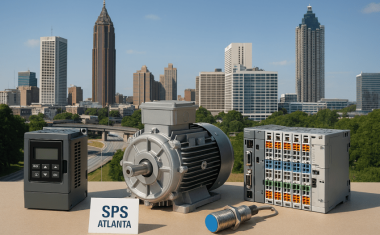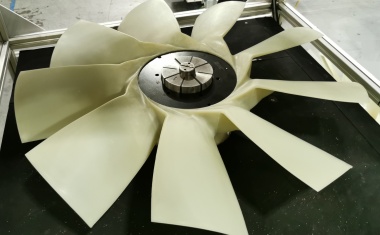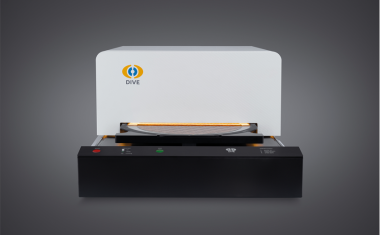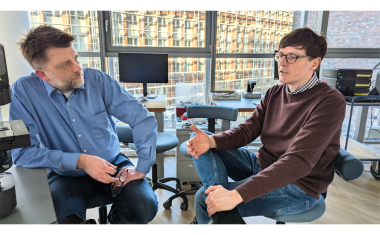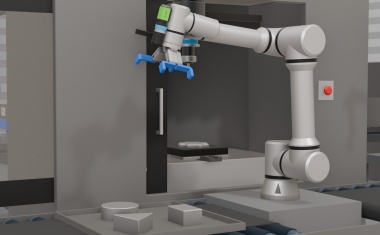Sustainable Quality Assurance
The global output of solar cells showed 85 % growth in 2008 and reached a level of 7.9 Gigawatt. This even exceeded the growth record of 2007 at 69 % and a production of 4.3 Gigawatt. Germany contributed 18.5 % to the global production in 2008 compared to 20.5% the year before. In the industrial production of photovoltaic modules, optical inspection systems ensure a consistently high quality of the products and a high throughput.
The demand for increasingly powerful, high-quality and affordable products is steadily growing. Solar cells are constantly becoming more finely structured and thus increase the requirement for precision during production more and more. To achieve these objectives the use of optical inspection systems in addition to electrical performance tests is mandatory. On top of assuring the qualitative classification of the individual parts the optical inspection systems provide valuable data about the manufacturing pro-cess and thereby open up potential for optimization and cost savings on the manufacturing side. With the G/Solar product range, Graphikon offers a whole set of optical inspection systems for solar cell production, module assembly and glass-based thin film production.
Thin Layers on Large Surfaces
For more than 30 years now solar cells based on amorphous silicon, so-called thin-film modules, are in use. In order to achieve consistent high module efficiency for these modules, they are inspected automatically and process-oriented during production. In many cases optical inspection systems are the technology of choice here. Graphikon offers, under the brand G/Solar Thin Film, a complete series of inline inspection systems for thin film production. Unlike conventional flat glass inspection systems, which cover the entire conveyor width with a large number of line scan cameras, the
G/Solar Thin Film systems need only one camera module.
The camera modules, designed especially for the thin-film photovoltaic inspection, are moved motorically over the surface and thus scan 100% of the substrate within the cycle time of the production line. This economical use of very high quality components results in a significant cost advantages for the customer.
Compared with conventional systems G/Solar Thin Film provides improved detection performance, since the sensor configuration can be adapted flexibly to the optical properties of the substrates. In particular the use of telecentric lenses leads to significantly better images of mirroring reflective surfaces than achievable with conventional lenses. These lenses are used in the manufacture of silicon thin-film modules, CdTe (cadmium tellurite) and CIGS (copper, indium, gallium, sulfur and selenium) after each process step up to the deposition of the absorber layer. In the following step, a special dark field system is used, which can also be employed for most back-end applications. The color version of the system evaluates the homogeneity of the surface color.
For most applications, it is necessary to capture images of the substrates with several different optical configurations, such as in reflected light and transmitted light, to enable inspection of all necessary structures. The design of the G/Solar Thin Film system allows for the first time ever, the independent application of various different contrasting methods in one scan run. For this reason it offers images with best dynamics.
From Wafer to Solar Cell
The series G/Solar Cell was developed especially for the area of cell manufacturing. For virtually every manufacturing step, from the wafer up to the finished cell, quality can be monitored and pro-cesses can be controlled in an optimal way. The geometry measurement, the inspection of texturing and of the AR-layer, screen print inspection and the detection of micro cracks are the important tasks. Finally, the same systems are employed in the cell sorters, and will be complemented here with hotspot detection and electroluminescence inspection.
A major focus for quality control is the screen print inspection. With the HighRes system version the middle finger width can be measured down to a precision of ± 0.005 mm. Further quality criteria are interruptions, neckings, alignment to the cell and dimensional accuracy, e. g.
Another important task is the inspection of the anti-reflective coating. During production, the silicon wafers are covered with their typical blue layer. An inspection of this layer can be executed directly after coating or after screen printing of the cells, without the need to pre-define the exact structure of the printing. For quality measure of the anti-reflective layer the operator is interested in the homogeneity of the surface, the color classification for optical appealing modules and the coating thickness. The coating thickness can be measured with an accuracy of up to ± 2 nm, reproducibly on all systems.
In addition to the purely optical inspection systems, the hotspot and the electroluminescence systems are in use. In both systems, the cells are supplied with current. Local short circuits appear as local heating (hot spots) when the cells, which behave like diodes, are operated in the reverse direction. This method, developed together with the Deutsche Cell, allows the user to assess whether a cell contains critical short circuits in a time span as short as 0.3 s. On the other hand the cell is operated in the conducting direction, which then leads to self-illumination (luminescence). Due to the electroluminescence effect defects are becoming visible that cannot be seen in the classical reflected or transmitted light: very fine interruptions of the screen print, micro-cracks and inactive areas of the cell.
Many Cells Securely Packed
The finished cells are packed into modules with, e. g., 72 cells. For the cell sorting, the cell sorter is used. Here, the inspection of the rear and front printing, the color and the hotspot control are employed. In further processing steps, the individual cells will at first be combined to strings (a series of interconnected cells), then several parallel strings are mounted to a module. For the mounting of the strings, the cells will first be aligned optically. After completion of a string it will be visually inspected. This evaluation includes among other things the geometry of the string, the position of individual cells, the presence of solder and the position of the strings for optimal spacing between the strings.
After all strings have been placed, any remaining defects can be fixed one last time before laminating, using the layup inspection. Finally the subsequent laminate inspection serves the qualitative assessment and the process control.
Commonalities despite Specialization
All Graphikon systems use matrix cameras in conjunction with flashed LED lighting. This combination ensures maximum accuracy of the cameras as well as maximum durability of the lights. Additionally different lighting scenarios are viable in a flexible flow. Thanks to patent-protected contrasting methods, combined with innovative calibration procedures, the systems obtain the highest achievable accuracy. The assessment of the inspected products is done by a freely configurable classifier based on the specific characteristics identified. The inspection systems series is rounded off by customer-specific solutions such as a control framework.
Graphikon has been providing inspection systems for the photovoltaic industry since 2004. Based on 20 years of industrial experience and due to their innovative technology these systems are setting standards in the fields of quality assurance and process control.



